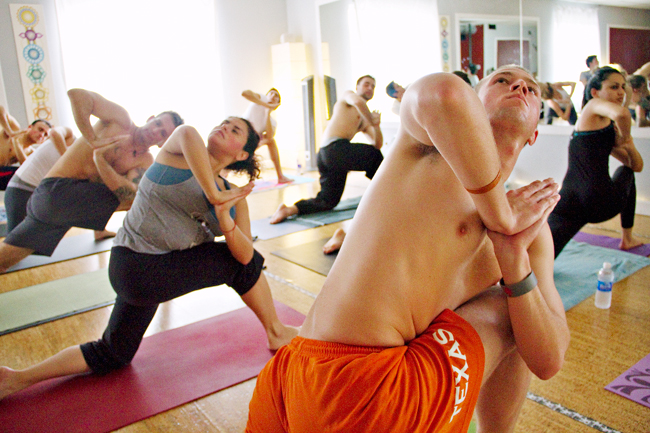Imagine floating aimlessly along in your thoughts, forgetting tomorrow’s worries and soaring through the present. That is, until an exhausted man to your right starts getting out of the shavasana position and begins to fold his towel and roll up his mat.
Shavasana, or corpse pose, is common at the end of the practice known as Bikram yoga. It is the perfect time to free your mind or just melt into the warm floor after an hour of twists and openers that will have undoubtedly left your body exhausted.
Bikram yoga was founded by Bikram Choudhury, an Indian yoga guru who won the National Yoga Championship at 11-years-old. The practice involves the same 26 poses and is done in a room that is heated up to 105 degrees. In Bikram, sweating is essential to a successful practice. The terms “sweaty yoga” or “hot yoga” are common phrases to describe variations in the workout.
According to Bikramyoga.com, the room is heated to make the body soft enough to sculpt and be flexible while “flushing away the waste products and impurities out of your body through the skin,” much like a sauna. The kidneys and liver are organs that help dispose of unneeded waste in the body, and the skin works the same way through sweating.
Sweating is not only a release physically, but mentally as well. Dean Mahan, owner and instructor at Yoga Vida studio in Austin, always has soothing words for his yogis.
Mahan often says “let go of your ego,” to remind everyone to focus on themselves and their abilities, rather than how easily the woman on the mat in front of them can fold into her headstand.
“I began on Nov. 2, 13 years ago and I have practiced every day since,” Mahan said. “It shows how much you want to practice by simply showing up to your mat every day.”
Not all “hot” or “sweaty” yoga is Bikram, because Bikram has a disciplined routine of poses and uses hotter and drier temperatures. Prospective practicers will find that each studio and instructor has his or her own take on routine techniques.
The atmosphere in a traditional Bikram class is stricter than a sweaty class. When you enter a Bikram studio, there is an immediate wave of hot air that overwhelms you as soon as you step through the door, thus making the sweat pour instantly. Sweaty classes are sometimes mistaken as Bikram because of their similarities, but the temperatures in sweaty classes are always lower.
The setting in Bikram classes are much more disciplined. Words aren’t often spoken before classes so individuals can focus all of their energy on the movement of their bodies. Most instructors advise students to free their minds and focus any thoughts away from the stress of their day.
Even though Yoga Vida, an Austin yoga studio, follows more traditional Bikram techniques than other studios in the area, the studio doesn’t enforce the consecutive performance of all 26 poses, and each class incorporates as many poses in whichever pattern the instructor wishes.
“If you’re trying to go into a backbend and immediately use your head as a crutch, you are going to have neck and back problems. In class we teach you how to get in and out of poses appropriately so that you don’t end up hurting yourself,” said Vic McWherter, an instructor at Yoga Vida.
Studios like Black Swan Yoga, which runs on suggested donations of about $10 per session, are popular with college students. Black Swan offers a sweaty class multiple times a day. Sweaty classes are as close to Bikram as you can get without all of the discipline, especially if you enjoy a more laid back workout with Radiohead rocking in the background and more lenient etiquette. Sweaty classes are also slightly cooler, with temperatures in the 90s, and the air is dry and the conversation lively.
“Forget about fidgeting. Clear your mind and devote your practice to someone or something. Think about that devotion when your practice begins to get too tough,” yoga instructor Stacie Hawk said in one class.
There are plenty of Bikram studios around town, but it’s essential to find one that suits you. If you don’t like the airy, spiritual mantras, find a studio that focuses strictly on the physical aspects of yoga.
“What’s better than going to work out and actually enjoying it? Every time I practice, I sweat out all my negative energy and breathe in the positive,” said geography senior Joane Guiling.
If leaving the house for 60 to 90 minutes for an intense calorie-burning and stress-reducing workout isn’t exactly your idea of a good time, try a few sun salutations each morning to awaken your inner yogi. Bikram is useful whether you need a break from studying and need to free your mind or are feeling tired and need the extra boost. Go enjoy the practice and namaste.
Printed on Tuesday, January 31, 2012 as: Sweating out stress, Bikram yoga turns up heat in Austin




















